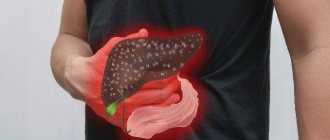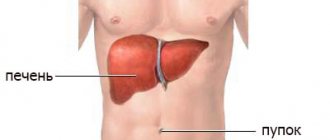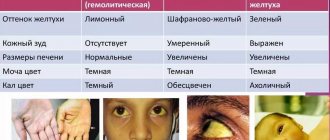We continue to consider viral diseases that affect the liver and can threaten human life.
Hepatitis is a viral disease in which the liver is destroyed due to harmful microorganisms. And the statistics are not very reassuring.
Every fifteenth resident of the Russian Federation is infected with one of the hepatitis viruses, and in every tenth the disease has become chronic.
About half of all infected people do not even know they are sick. Chronic viral hepatitis causes severe liver disease and can even be fatal.
One of the most dangerous and little-studied hepatitis viruses is the delta virus, which is also called hepatitis D. In this article we will look at this infection in detail.
Territorial distribution
A study published in 2021 in the Journal of Hepatology1, carried out in collaboration with WHO, estimates that hepatitis D virus affects nearly 5% of people with chronic hepatitis B worldwide and approximately one in five cases of liver disease and liver cancer. in those infected with hepatitis B is associated with co-infection with hepatitis D. The study identified several geographic areas of high prevalence of hepatitis D, including Mongolia, the Republic of Moldova and several countries in West and Central Africa.
Liver maintenance and restoration
In order to maintain the body in a stable state, you need to eat right, adhere to diet No. 5, and follow the instructions of your doctor. There are many medications that can stabilize the general condition of the liver. It is also worth remembering to take vitamins and minerals. But it is best to check the dosage with a doctor, since before taking them, you should pass all the necessary tests to determine the deficiency or excess of a particular vitamin in the patient’s body.
Doctors recommend drinking more rosehip infusion and eating black currants, as this helps increase vitamin C deficiency.
Symptoms
Acute hepatitis: Co-infection with hepatitis B and D viruses can lead to moderate to severe hepatitis and in some cases fulminant hepatitis, but complete recovery usually follows and chronic hepatitis D is rare (in less than 5% of cases). cases of acute hepatitis).
Superinfection: a person who already has chronic hepatitis B can become infected with the hepatitis D virus. Superinfection with hepatitis D against the background of chronic hepatitis B leads to the accelerated development of more severe forms of the disease in 70-90% of patients, regardless of age. Patients superinfected with hepatitis D develop cirrhosis nearly 10 years faster than patients infected with hepatitis B alone, even though hepatitis D virus suppresses hepatitis B virus replication. Why hepatitis D virus causes more severe disease and the accelerated development of fibrosis compared with hepatitis B monoinfection remains unknown.
How do symptoms change with delta particle superinfection?
- With a favorable course of the chronic process, the addition of virus D sharply worsens the patient's condition with the development of intoxication with high fever, pain in the joints and right hypochondrium. This continues for five days until jaundice appears.
- Usually, when jaundice appears, the condition improves and the symptoms of the disease decrease, but with superinfection this does not happen.
- When the jaundice fades and the manifestations of the disease decrease, an exacerbation suddenly occurs with an intensification of all manifestations, then it begins to improve again, when suddenly it worsens again. This process is called “waves”.
- The liver does not tolerate two infectious agents at once, its functionality decreases, and liver failure develops.
- Fibrosis and cirrhosis of the liver develop faster, which raises the question of liver transplantation after a decade of illness, while only chronic B the process proceeds three times slower.
Who is at risk?
Carriers of chronic hepatitis B are at risk of contracting hepatitis D.
Individuals who are not immune to hepatitis B (i.e., have not had the disease or have not been vaccinated against hepatitis B) are at risk for contracting hepatitis B, which in turn is a risk factor for contracting hepatitis D.
Groups at high risk of co-infection with hepatitis B and D viruses include people who inject drugs, indigenous peoples and hemodialysis patients. Patients on hemodialysis, men who have sex with men, and sex workers also appear to be at increased risk of co-infection.
Antiviral therapy
Antiviral therapy is one of the methods of drug treatment for a patient, based on blocking HBV infection. This method of combating the disease is the most effective and basic, which can subsequently be enhanced by other methods of treatment, for example, folk remedies or diet. It takes about six months to completely cure a patient of hepatitis D. During this period of time, the components of the drug help not only block the virus, but also prevent damage to other cells.
Screening and diagnosis
Diagnosis of hepatitis D is carried out by detecting a high concentration of antibodies to the hepatitis D virus of the class immunoglobulin G (IgG) and immunoglobulin M (IgM); To confirm the diagnosis, a serological test for hepatitis D virus RNA is performed.
However, diagnostics for hepatitis D are poorly available, and hepatitis D virus RNA tests, which are used to monitor response to antiviral therapy, are not standardized.
If quantitative testing for hepatitis D virus RNA is not available, it is advisable to perform a serological test for HBsAg to monitor response to therapy. A decrease in HBsAg titer often indicates disappearance of this surface antigen and clearance of the hepatitis D virus, although disappearance of surface antigen is rare in patients undergoing treatment.
Folk remedies
It is worth noting that some patients try to be treated the “grandmother’s” way, but this is not always effective, since before you start taking any infusion, you need to consult with your doctor to eliminate side effects and other consequences. Only a doctor can understand whether this decoction, combined with the main treatment, will help or not. Traditional medicine is an auxiliary method of treating ailments, which in most cases supports the functioning of the entire body.
So that the cells of a vital organ can recover, it is best to take a herbal mixture: mix St. John's wort, calendula, immortelle, chicory, chamomile, knotweed, and buckthorn in equal parts. Then set aside 4 tablespoons of this mixture and fill it with 500 ml of water at room temperature, cover with a lid and leave the mixture until the morning. In the morning, the contents must be poured into a saucepan and boiled for 5 minutes, then allow the broth to cool. Doctors recommend taking this decoction half a glass 3-4 times a day before meals. It is best to drink this infusion not cold, but warm.
Treatment
Current guidelines generally recommend pegylated interferon alfa for at least 48 weeks, regardless of response to treatment. With this treatment, the overall rate of sustained virological response is low, but its administration is an independent factor associated with a lower likelihood of disease progression.
Patients with fulminant hepatitis and end-stage liver disease may be candidates for liver transplantation. The development of new drugs and therapeutic strategies is required, and preliminary trials of some new drugs, such as prenylation inhibitors or hepatitis virus entry inhibitors, have shown initial positive results.
More efforts are required to reduce the global burden of chronic hepatitis B and develop safe, effective and affordable hepatitis D drugs; this would ensure widespread access to treatment for those who urgently need it.
Consequences and prevention
Complications of viral hepatitis D include the development of cirrhosis, liver failure, and malignant neoplasms. If the disease is detected early, complete restoration of liver function is possible, but it may take several months.
There are two main methods of preventing hepatitis D. The specific method is to administer a vaccine against hepatitis B. Since this protects a person from the B virus, the possibility of the delta virus multiplying in the body is eliminated.
Non-specific methods of prevention include the use of only disposable instruments during medical and other manipulations, condom-protected sexual intercourse, and abstinence from drugs.
WHO activities
In May 2021, the World Health Assembly adopted the first Global Health Sector Strategy on Viral Hepatitis 2016–2021. The strategy emphasizes the critical role of universal health coverage and aligns its objectives with those of the 2030 Sustainable Development Goals. The strategy's overarching goal is to eliminate viral hepatitis as a public health problem and is reflected in global targets to reduce the number of new cases of viral hepatitis infection by 90% and reduce deaths from viral hepatitis by 65% by 2030. The strategy sets out the actions that countries and the WHO Secretariat must take to achieve these targets.
WHO has not published specific recommendations for hepatitis D; Effective means of preventing hepatitis D infection include prevention of hepatitis B transmission through vaccination, including timely administration of the first dose of vaccine immediately after birth, additional preventive antiviral therapy for pregnant women with appropriate indications, ensuring blood safety, maintaining injection safety when providing medical care, as well as health care services. reducing harm associated with injecting drug use, such as providing sterile needles and syringes. WHO is supporting Member States to scale up these evidence-based interventions.
In addition, to support countries in meeting the global hepatitis targets of the 2030 Agenda for Sustainable Development, WHO is working in the following areas:
- raising awareness, facilitating partnerships and mobilizing resources;
- developing evidence-based policy and collecting data to inform action;
- improving health equity in the hepatitis response;
- preventing transmission of infection;
- expanding coverage of screening, care and treatment services.
WHO also observes World Hepatitis Day on 28 July each year to raise awareness and awareness of viral hepatitis. In 2021, World Hepatitis Day will be held under the theme “A future without hepatitis” and will focus on the prevention of hepatitis B (and hepatitis D), including the prevention of mother-to-child transmission of hepatitis B.
1 Stockdale AJ, Kreuels B, Henrion MYR, Giorgi E, Kyomuhangi I, de Martel C, Hutin Y, Geretti AM (2020). The global prevalence of hepatitis D virus infection: systematic review and meta-analysis. J Hepatol. Published online 23 April 2020; https://doi.org/10.1016/j.jhep.2020.04.008
Diet
For viral hepatitis, patients are prescribed diet No. 5. The main purpose of its use is to improve the functioning of the digestive tract and reduce the secretion of digestive juices. The following principles must be followed:
- Food intake should be in minimal portions at least 4 times a day.
- Dishes must be warm, cold and hot are excluded.
- You should not eat foods containing large amounts of spices and essential oils.
All fatty fish and meats, smoked meats, chocolate, fresh baked goods, pickled preparations, and too salty and spicy dishes are excluded from the diet. The emphasis should be on plant and dairy foods, cereals. A sufficient amount of liquid in the form of compotes and rosehip decoctions will help free the body of toxins.
Possible complications
If there is no treatment for such a disease, then this is fraught with the development of consequences that pose a threat to the patient’s life, namely:
- liver failure;
- cirrhosis of the liver;
- transition of the disease to a chronic course - in such situations it is much more difficult to cure the infection;
- dysfunction of other internal organs - the most common targets are the heart and kidneys;
- sepsis;
- internal bleeding;
- premature birth - when women are infected with HDV during pregnancy.
Preventive measures
The occurrence of co-infection can be prevented: it is enough to get a vaccine against hepatitis B or inject a specific immunoglobulin into the blood. Vaccination in many countries of the world is given to children according to the vaccination calendar, and this measure allows many to save lives.
Hepatitis B vaccine
The risk of superinfection can be reduced by prevention methods. Firstly, if possible, it is necessary to exclude long-term contacts with infected people and avoid casual sexual intercourse. Secondly, you need to choose professional beauty salons and contact trusted tattoo and piercing artists. In addition, hospitals also need to be careful and closely monitor the use of needles when drawing blood. Thirdly, you need to take care of personal hygiene and not use other people’s machines, toothbrushes and other hygiene products.
As a rule, viral diseases spread most easily in densely populated cities and countries with unsanitary conditions. For this reason, extreme caution must be exercised when traveling to warm countries.
Signs of hepatitis D
The first symptoms of hepatitis D do not appear immediately. The incubation period lasts from 21 days to 6 months. Therefore, a sick person can transmit the disease further without knowing about the infection. Hepatitis B, HIV infection, tuberculosis, herpes reduce the duration of this period.
This is interesting: HBsAg and HCV blood test: what is it, indications, explanation
The disease can be acute or chronic. In acute cases, all signs appear quickly. Timely treatment allows you to completely get rid of the pathology.
The chronic form occurs in 80% of cases. It is characterized by a long, sluggish course and erased symptoms.
The patient develops the following symptoms:
- Pain in the right hypochondrium.
- Enlarged liver. Sometimes the spleen may also become enlarged.
- Nausea, heartburn, belching, bitterness in the mouth.
- Weakness, fatigue.
- Decreased appetite, weight loss.
- Low-grade fever.
- Bloating, rumbling, seething in the stomach.
- Flatulence.
- Jaundice discoloration of the skin and eyes.
- Spider veins on the body.
- Soreness in muscles or joints.
- Unstable or unformed stools.
- Skin itching.
Due to impaired absorption of bilirubin, stercobilin and urobilin, the patient develops discolored feces and dark-colored urine.
The patient also develops hepatic encephalopathy: headaches and noise in the head. Cognitive disorders are observed: decreased attention, thinking abilities, memory.
Treatment of hepatitis D co-infection and superinfection
The main goals of hepatitis D treatment are to stop the replication of the virus, reduce the risk of complications and improve the patient's condition.
Principles of treatment for hepatitis D, such as for hepatitis B:
1. Pathogenetic therapy
- hepatoprotectors to activate the processes of restoration of hepatocytes and protect them from negative factors (Gepabene, Heptral, Essentiale, Silibor, Karsil and others);
- enterosorbents to accelerate the removal of bilirubin and viruses from the body (Enterosgel, Laktofiltrum and others);
- detoxification therapy involves infusions of colloidal and saline solutions that will reduce intoxication of the body (5% Glucose, 0.95 Sodium Chloride, Reosorbilact, Ringer-Lactate, Disol, Trisol, etc.);
- glucocorticosteroids (Prednisolone, Dexamethasone);
- antispasmodic therapy (No-shpa, Papaverine);
- choleretic therapy (Ursohol, Ursosan, Cholesas);
- vitamin preparations (cyanocobolamine, nicotinic acid, ascorbic acid and others).
2. Etiotropic therapy. The most effective and frequently prescribed antiviral therapy regimen is a double combination of Ribavirin and Interferon. The course can last from 6 to 12 months. During treatment, the body’s viral load must be determined to monitor the effectiveness of therapy. A more modern treatment is considered to be a triple combination scheme of Ribavirin, short-acting Interferon with pegylated Interferon.
3. Diet. With hepatitis D, as with other viral hepatitis, you should follow diet No. 5:
- You should drink 1.5-2.5 liters of water per day;
- food is taken in small portions;
- It is prohibited to consume alcoholic beverages, essential oils, fatty, fried and spicy foods, as well as pickles, smoked meats, lard, sweets, baked goods, and sweet soda;
- the temperature of the food should not exceed 35-36°C;
- It is better to bake, boil or steam food;
- the daily diet should consist of cereals, liquid soups, lean meats, fish, poultry, fermented milk products, vegetable oil, chicken protein and other easily digestible foods;
- do not overeat at night, so as not to overload the liver;
- daily food caloric intake - up to 3500 kcal.
4. Mode. The regime during the acute phase of the disease and during exacerbation of the chronic phase is bed rest. During the remission phase, you should limit physical and mental activity, spend time in the fresh air, and do light exercises.









